What’s Up?
I got down to the pier early and was glad I did as there was some nice sunrise silhouette color. And a Little Blue Heron foraged in just the right spots. Next, I created a few Osprey images. Then it clouded over completely, and the wind died to nothing, so I headed home to do some wildflowers in my front yard.
Today is Sunday 26 June 2022. The forecast for this morning if for sunny with increasing cloudiness and a breeze from the northwest. I will be heading down to the lake early to see what’s up. Wherever you are and whatever you are doing, I hope that you too have a great day. This blog post took about two hours to prepare and makes one hundred days in a row with a new one.
Please remember to use the B&H and Amazon links that are found on most blog pages and to use the BIRDSASART discount code at checkout when purchasing your new gear from Bedfords to get 3% back on your credit card and enjoy free second-day air FedEx. Please, also, consider joining a BAA IPT. You will be amazed at how much you will learn!
BIRDS AS ART Image Optimization Service (BAA IOS)
Send a PayPal for $62.00 to birdsasart@verizon.net or call Jim at 863-692-0906 and put $62.00 on your credit card. Pick one of your best images and upload the raw file using a large file sending service like Hightail or DropBox and then send me the link via e-mail. I will download and save your raw file, evaluate the exposure and sharpness, and optimize the image as if it were my own after converting the raw file in Adobe Camera Raw. Best of all, I will make a screen recording of the entire process and send you a link to the video to download, save and study.
Induro GIT 304L Price Drop
Amazingly, we have two, brand-new-in-the-box Induro GIT 304L tripods in stock. They are $699.00 each (were $799.00) and the price now includes the insured ground shipping to the lower 48 states. Weekday phone orders only: 863-692-0906.
|
|
Sunrise Silhouette Strategy from the Pier in June |
Discovering New Stuff
Though I’ve been photographing at Indian Lake Estates (ILE) for more than two decades, I did not realize that there were some good sunrise silhouette possibilities from the pier during the warmer months when the sun rises north of east. The more you photograph at a given location, the more you will discover and learn.
If I am out on the pier in the vicinity of B, and there is a bird or two in the vicinity of A, I can move east or west as needed to place the bird in the sunrise color (and make some nice images). Even on dead clear days, there may be some nice color just before or after sunrise. And if there are some light clouds on the eastern horizon, or some fog or haze, there can be some very good opportunities. All that I need to do is get down to the lake by 6:15am at the latest.
For more than two decades, I assumed that there simply were very few if any good sunrise situations at ILE. Go figure.
|
|
|
This image was created on 25 June 2022 down by the lake near my home at Indian Lake Estates, FL. Standing on the pier, I used the handheld Sony FE 400mm f/2.8 GM OSS lens with the Sony FE 2.0x Teleconverter, and The One, the Sony Alpha 1 Mirrorless Digital Camera). The exposure was determined accurately using Zebra technology. ISO 2000. 1/500 sec. at f/5.6 (wide open) in Manual mode. When evaluated in RawDigger, the raw file brightness was determined to be dead-solid perfect. AWB at 6:53:06am with some light clouds on the eastern horizon just after sunrise. Tracking: Zone AF-C with Bird Face/Eye detection enabled performed perfectly. Be sure to click on the image to enjoy a high-res version. Little Blue Heron adult fishing |
What Makes a Good Sunrise Situation on the Pier?
1- First, you need a subject. If there are no birds in the water close to the pier, you will go home empty-handed even with spectacular sunrise color.
2- Mornings with little or no wind will maximize the color (if any).
3- You need at least some sunrise color reflected in the water. As noted above, some light clouds or fog or haze can be your best friends.
4- There is some freshwater vegetation in the area denoted by the A in the diagram above. Sometimes including the vegetation in the frame can be a plus, but it often detracts. With today’s featured images I was glad to have the bird in open water.
|
|
|
This image was created on 25 June 2022 down by the lake near my home at Indian Lake Estates, FL. Standing on the pier, I used the handheld Sony FE 400mm f/2.8 GM OSS lens with the Sony FE 2.0x Teleconverter, and The One, the Sony Alpha 1 Mirrorless Digital Camera). The exposure was determined accurately using Zebra technology. ISO 2000. 1/500 sec. at f/5.6 (wide open) in Manual mode. When evaluated in RawDigger, the raw file brightness was determined to be dead-solid perfect. AWB at 6:53:06am with some light clouds on the eastern horizon just after sunrise. Tracking: Zone AF-C with Bird Face/Eye detection enabled performed perfectly. Be sure to click on the image to enjoy a high-res version. Little Blue Heron adult striking |
The Gear and How I Used It
Most mornings, I head onto the pier with the handheld 400mm f/2.8 GM lens with the 1.4X TC and an Alpha 1 attached. The 2X TC is in my fanny pack, along with the TC caps, in case I want to go to the bare lens alone. If I see a Green Heron or two on the small pilings to the north of the pier, I will usually bring the tripod along. On some mornings — don’t ask me why, I will bring the 600mm f/4 GM lens along with both TCs and the tripod. I am always happy with my choice. Why? Because happiness itself is a choice. (Byron Katie — www.The Work.com)
Anyhoo, on Saturday morning I mounted the 2X TC as the possibility for some sunrise color existed. There was some very nice color early on, but the sun was a bit too bright, and the bird was fishing in the vegetation. But the time it made its way into clear water, there was just a hint of color left. Resting my left forearm and the pier railing I set the shutter speed at 1/500 second and increased the ISO until I had some Zebras on the water. With my Zebra values set perfectly, this ensures a perfect or dead-solid perfect exposure. In a span of about seven seconds, I created more than 40 images. The herons and egrets will almost always give you a sign that they are about to strike by retracting the feathers on their head and neck. At that point, I hold the shutter button down to take advantage of the a1’s 30 frames per second. So, that is exactly what I did. I kept two of the seven images that showed the splash. The fish was a tiny one.
|
|
|
Click on the image to better see the green eye-AF boxes in action. Sony Alpha 1 Flight Photography AF Points! |
The SONY Alpha a1 Set-up Guide and Info Group: $150.00 (or Free)
The SONY Alpha a1 Set-up Guide and Info Group is going great guns as more and more folks chime in with thoughtful questions and experience-based answers. As the a1 is becoming more readily available, more and more folks are getting their hands on this amazing body. By June 1, 2022, the group was up to an astounding 124 lucky and blessed folks. (More than a few folks own two or more a1 bodies! Early on, we discussed the myriad AF options. I gave my opinion as to the best one for flight and general bird photography. The best news is that everyone in the group receives an e-mail that includes a .DAT file with my a1 settings on it, and explicit directions on how to load my settings onto your a1; talk about convenience! I am now offering a .DAT file compatible with firmware update 1.20. Your entry into the group includes a consolidated Sony a1 CAMSETA2 INFO & GUIDE. New a1 folks will now receive six e-mails instead of the previous 28! You will receive new e-mails as they are published. Simply put, this e-mail guide is an incredible resource for anyone with an a1.
All who purchased their Alpha 1 bodies via a BAA affiliate link — B&H or Bedfords — will receive a free Sony Alpha a1 Set-Up Guide and free entry into the Info Updates group after shooting me their receipts via e-mail. (Note: it may take me several days to confirm B&H orders.). Others can purchase their guide here in the BAA Online Store.
|
|
The BAA Middle of Florida Photographic Site GuideYou can purchase your copy here in the BAA Online Store. |
The BAA Middle of Florida Photographic Site Guide
126 pages, 87 photographs by Joe Przybyla and Arthur Morris.
The PDF for this e-Guide is an electronic download sent via e-mail.
Purchase your copy here in the BAA Online Store.
I had thought about doing a guide to some of the great but little-known photo hotspots around central Florida for about a decade, but those plans never came to fruition. I met Joe online in the Avian Forum at BirdPhotographer’s.Net about two years ago. Joe’s photography has improved tremendously over the past few years; he credits the BAA blog, my books and PDFs, and his participation on BPN. The one thing that I learned right from the get-go about Joe is that he is a hard and tenacious worker, always striving to improve his skills and to grow his knowledge base. As he knew of more than a few good spots in central Florida, I broached the idea of us doing a photographic site guide that covered many of the little-known photographic hotspots from Brandon to Lakeland to Joe Overstreet Road to Indian Lake Estates (my Florida home for the past 20 years or so). After more than many, many dozens of hours of effort, The BIRDS AS ART Middle of Florida Photographic Site Guide is now a reality. Thanks to Joe’s wife Dottie for her review of our writing. We all learned once again that writing is a process, a back-and-forth process. All thanks to the white pelicans of Lakeland. Here are the locations that are detailed in this e-Guide:
- Indian Lake Estates: Sandhills Cranes with chicks and colts, lots of vultures, and Ospreys up the kazoo!
- Gatorland, Kissimmee: Learn to make great images of wading birds in a cluttered rookery.
- The Brandon Rookery: Great for nesting Wood Storks, Great Egrets, and more.
- Circle Bar B Reserve, Lakeland: Here you will find a great variety of avian subjects in a great variety of habitats.
- Lake Morton, Lakeland: There are lots of silly tame birds here including and especially American White Pelican during the colder months.
- Lake Mirror, Lakeland: Tame Anhingas, Limpkins, and a zillion White Ibises at times.
- West Lake Parker, Lakeland: Here you will have a chance for two difficult birds, Snail Kite, and Purple Gallinule.
- Joe Overstreet Road, Kenansville: Crested Caracara, meadowlarks, Loggerhead Shrike, and much more on the fenceposts and barbed wire.
Each location includes a map, a detailed description of the best spots, best season, light and time of day instructions, the expected species, and an educational and inspirational gallery that is designed to open your eyes as to the possibilities.
You can purchase a copy here in the BAA Online Store.
Typos
With all blog posts, feel free to e-mail or to leave a comment regarding any typos or errors.

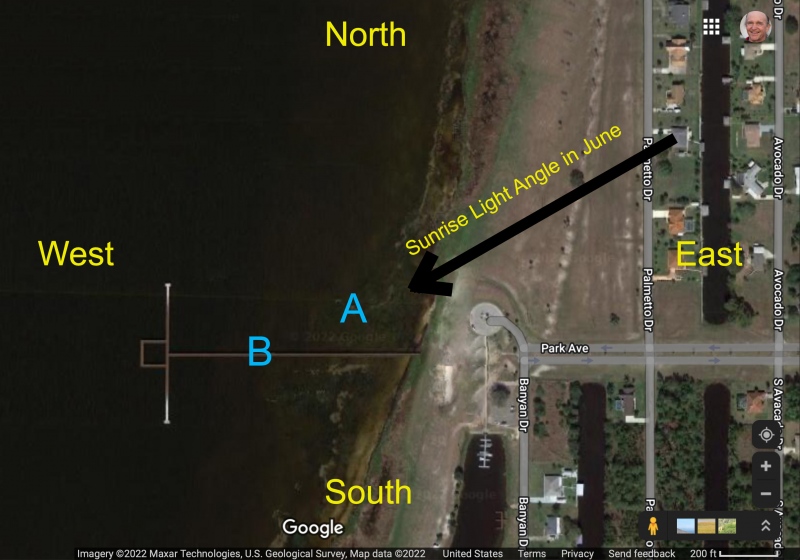
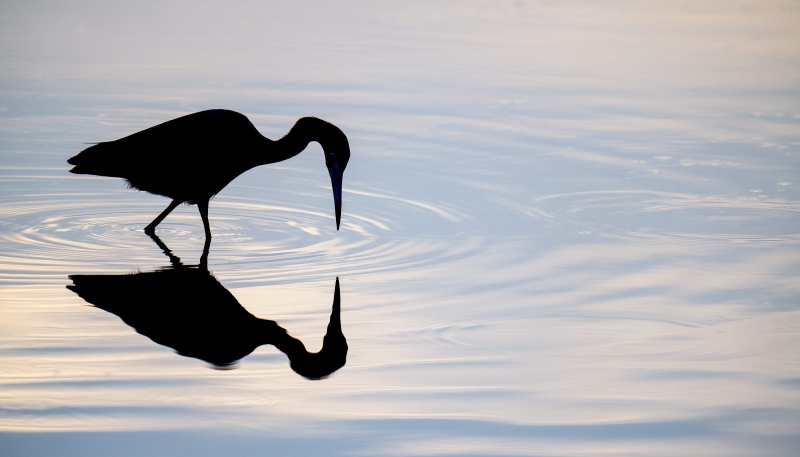
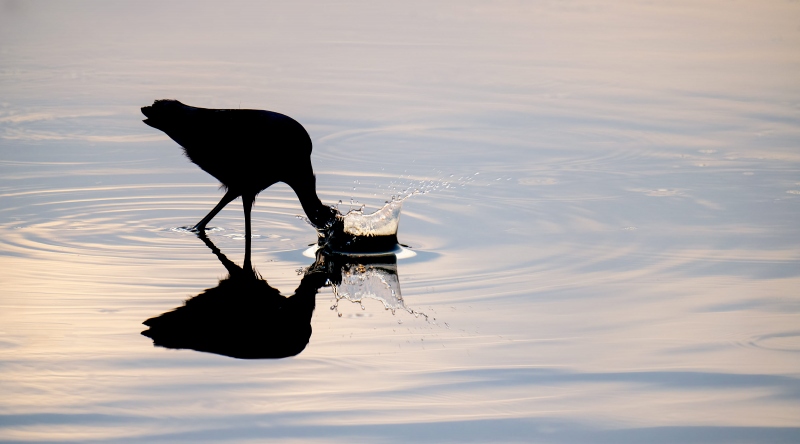
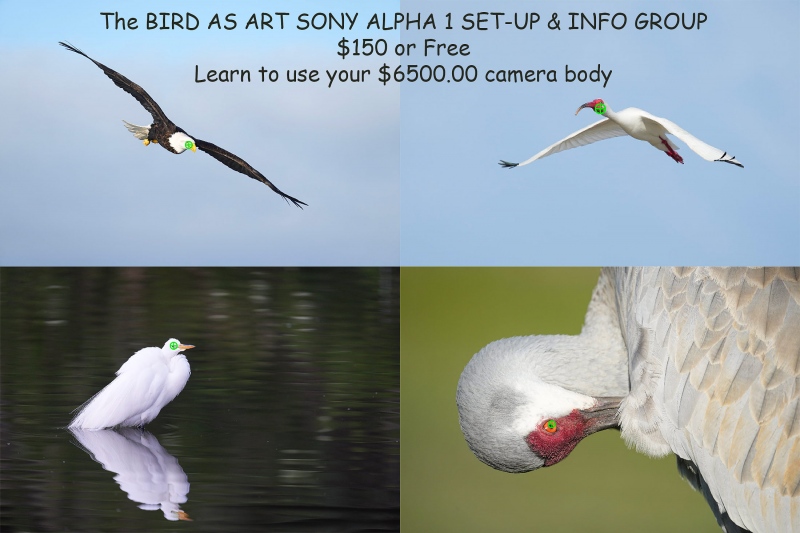
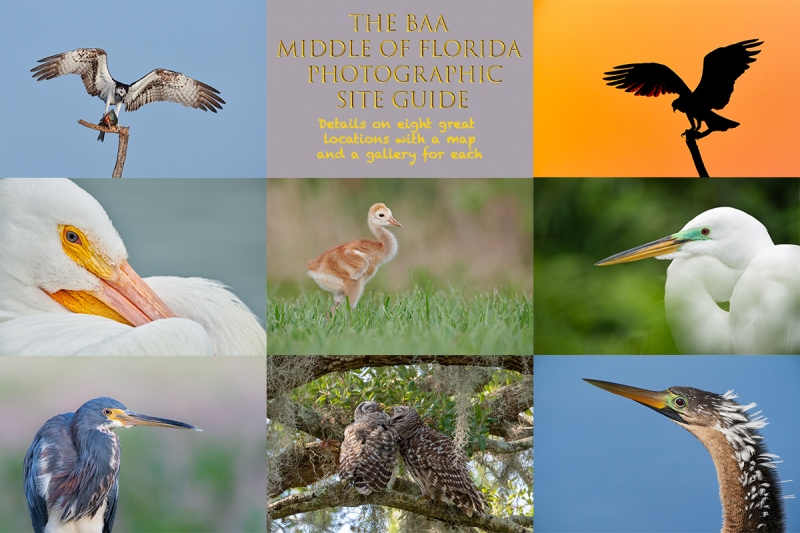













Good ?? David! Art your explanation makes perfect sense. Thanks.
Nice silhouette!
What is the difference between a “perfect” and a “dead-solid perfect” exposure?
Hey David,
My invented terms. When the G channel makes it 2/3 of the way from the 8000 line to the 1600 line I call that a perfect exposure. When the G channel closely approaches the 16000 line, I call that a dead -solid perfect exposure.
with love, artie
ps: Even “very good” exposures, where the G channel reaches 1/3 of the way from the 8000 line to the 16000 line, are much better than what many folks are doing — severely under-exposing their raw files.
Thanks for the explanation, Artie.